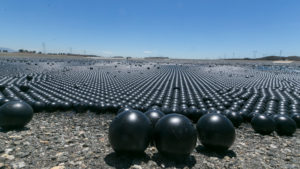
Damian Dovarganes | AP
You might remember around this time last year, millions of plastic “shade” balls were being unleashed on reservoirs in Southern California. Much to the chagrin of arm-chair quarterbacks everywhere, news about using plastic spheres to prevent evaporation and algae growth at reservoirs seemed like a very strange idea.
We followed up with David Pedersen, General Manager at Las Virgenes Municipal Water District about how well these 4″ plastic balls have held up in the year since.
At Recycled Water Reservoir #2 at the LVMWD campus in Calabasas, California, they were added to protect water quality. The addition of the balls were apart of a large improvement project that started in February 2015. The project included draining their old reservoir, relining and removing the sediment, re-filling and covering with shade balls.
“The shade balls have really served us well,” said David Pedersen. “The water quality in our reservoir has improved immensely and we no longer have turbidity problems that impair our ability to use and/or discharge the recycled water.”
There have been “no problems whatsoever” with how well the shade balls have held up to the elements.
A year later, plastic shade balls are still working to prevent algae growth, evaporation and improve water quality at a reservoir.



Leave a Reply